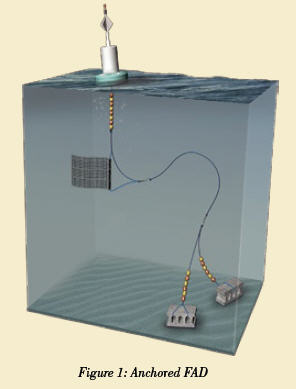Fish Aggregating Devices (FADs) and Tuna: Impacts and Management Options
This report provides an overview of current literature on fish aggregating devices (FADs) and their impacts on tuna populations. It provides specific information on types of FADs, associations of tuna species with FADs, negative impacts of FADs on tuna populations, methods of limiting negative impacts on tuna and possible management options. Although bycatch of non-tuna species associated with FAD fishing can be significant, it is not the focus of this review.
The main findings for the negative impacts of FADs on tuna populations are:
- Recruitment overfishing of skipjack tuna in the eastern Atlantic Ocean.
- Overfishing of bigeye tuna in the western and central Pacific Ocean from a combination of purse seine fishing around FADs and longline fishing.
- Decreased health of tuna caught near FADs compared with tuna caught in free schools.
- Increases over time in biomass under FADs, reduced free-school abundance, differences in fish sizes and ages compared with free-school caught tuna and alterations in school movement patterns as a result of behavioral changes by tunas around FADs in the Pacific Ocean.
- Increased difficulty of properly assessing the status of individual tuna populations.
- High rates of bycatch, including sharks, sea turtles and juvenile tuna.
Management methods to document or reduce the negative impacts of FADs
Options that could be or have been used to limit the negative impact of FADs on juvenile tuna include:
- Prohibiting the use of FADs (prohibiting sets on FADs, the deployment of FADs or both).
- Restricting the depth of FADs.
- Vessel efficiency controls.
- Bans on discards.
- Bycatch limits.
- Restrictions on number of FADs used.
- Time and area closures (on FADs or for the entire fleet).
It should be noted that although some of these measures have been effective at times, all come with trade-offs such as difficulty in monitoring, loss of target catches, and fishing effort displacement.
...
Read the full report in both English (PDF) and Español (PDF).


America’s Overdose Crisis
Sign up for our five-email course explaining the overdose crisis in America, the state of treatment access, and ways to improve care
Sign up









